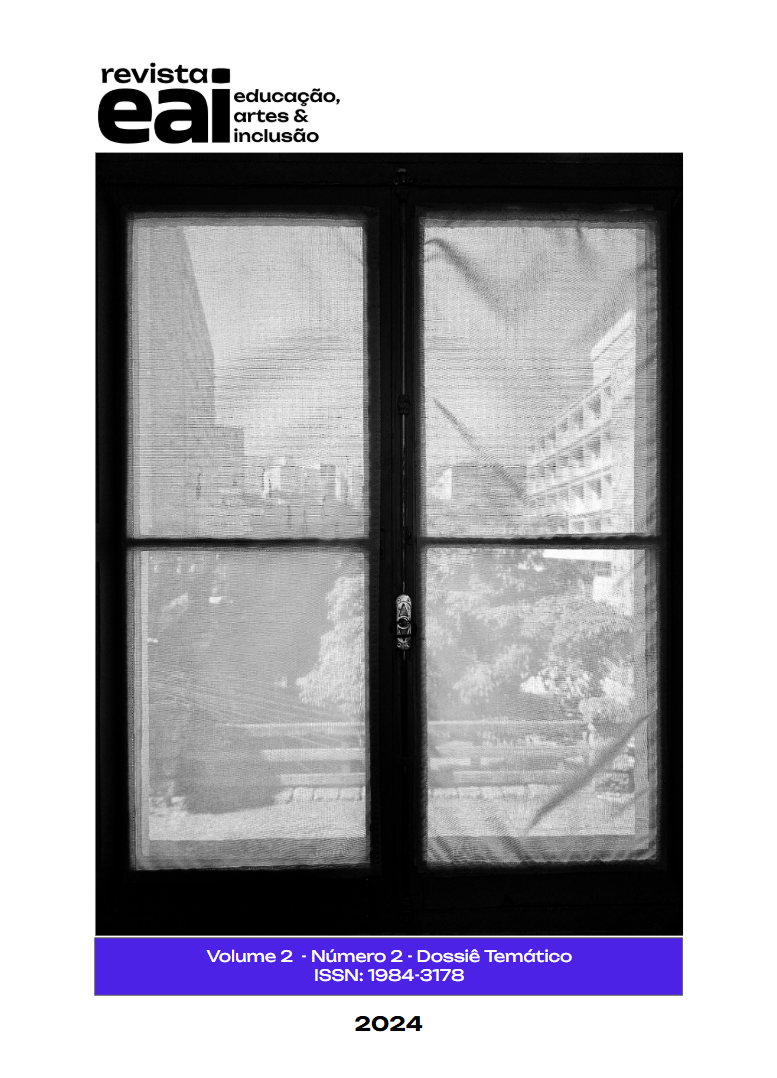Lugares de começos – Guardiões de memórias: onde se começaram a desenhar formas de pensar e fazer educação, mediação e participação
DOI:
https://doi.org/10.5965/198431782022024048Keywords:
arts, education, artistic mediation, cultural mediation, museum, communityAbstract
We believe in the depth of transformation latent in the combination of art and education, or in art as a way of proposing education. This union generates places of relationship where each person can meet themselves, the other and the others in themselves, and new ways of thinking about the key issues of contemporaneity, taking as a starting point the joint and sensitive construction of a fairer and more democratic society. This article reflects the realization of an artistic-cultural project, which we called Guardians of Memories built by many hands and many heads and subjectivities, in an exercise of co-creation between the school, the museum, which took off from art places and whose transdisciplinary approaches promoted moments of self-discovery and appreciation of the interpersonal and intercultural differences of all those involved. We're talking about a pioneering project between the a School Group and the a foundation with two art collections - two museums, and a starting point for thinking about the importance of artistic and cultural mediation projects, born of the school-museum union, and the importance of fruitful partnerships between the two, in the integral formation of people, regardless of their ages and diversities, and as a contribution to full citizenship. This partnership, which has decentralized both the school and the museum and created new territories and possibilities, has given rise to other ways of thinking about mediation and education, new rhizomatic paths that have expanded and been implemented in ways of doing things on both sides.
Downloads
References
Aboudrar,B.;Mairesse,F.(2016).La Médiation Culturelle.Paris:Presses Universitaires de France DOI: https://doi.org/10.3917/puf.aboud.2016.01
Acaso M. & Megias C. (2017).Art Thinking: como el arte puede transformar la education. Grupo Planeta.
Atkinson, D. (2012). Contemporary art and art in education: the new, emancipation, and truth. International Journal of Art & Design Education, 31 (1): 5-18. https://doi.org/10.1111/j.1476-8070.2012.01724.x DOI: https://doi.org/10.1111/j.1476-8070.2012.01724.x
Bourdieu, P. (2007). Escritos em Educação. Editora Vozes.
Bruguera, T.(2011). Pedagogia no campo expandido. Fundação Bienal do Mercosul
Carta de Porto Santo, A cultura e a promoção da democracia para uma cidadania europeia. (2021) Porto Santos e Lisboa : República Portuguesa, Plano Nacional das Artes e GEPAC
Charréu, L. (2018). A pesquisa educacional baseada nas artes (PEBA). Lisboa: Revista Portuguesa de Educação Artística
Cruz, H. (2022) Arte, Reinvenção e Futuros. Práticas Artísticas na Comunidade PARTIS 2019-2022, Fundação Calouste Gulbenkian
Dias, A. (2018). Transformar, criar, desafiar: o VII Congresso Matéria-Prima. Guardiões de memórias, ‘Fábrica de Projetos:’ projeto transdisciplinar e intergeracional Revista Matéria-Prima. 160-170. CIEBA—FBAUL, Lisboa. ISBN 978-989-8771-89-6
Eurydice (2012). A Educação para a Cidadania na Europa. Direção-Geral de Estatísticas da Educação e Ciência. doi:10.2797/21471
Great Art And Culture For Everyone-10-Year Strategic Framework (2013). Arts Council England
Helguera, P. (2011). Education for Socially Engaged Art A Materials and Techniques Handbook. Jorge Pinto Books.
Hirsch, M. (2008). The Generation of Postmemory. Poetics today 29:1. Porter Institute for Poetics and Semiotics. Duke University Press Poetics Today. 103-128 DOI 10.1215/03335372-2007-019 DOI: https://doi.org/10.1215/03335372-2007-019
Lafortune, J. (dir). (2012). La Médiation Culturelle: Le Sens des Mots et l'Essence des Pratiques. Presses de l'Université du Québec DOI: https://doi.org/10.1515/9782760533639
Leavy, P. (2015). Method Meets Art-Arts-Based Research Practice. The Guilford Press
Lopes, J. (2008). Da Democratização à Democracia cultural. Profeedições
Martins, P. F. R. (2024b). A Mediação Artística e Cultural na Escola: Perspectivas na primeira pessoa ou um lugar de fala para o mediador artístico-cultural a operar em contexto educativo e comunitário. Da Investigação Às Práticas: Estudos de Natureza Educacional, 14(2), e–372. Https://doi.org/10.25757/invep.v14i2.372
Manifesto Plano Nacional das Artes, (2019). Lisboa: Ministério da Cultura, Ministério da Educação e Plano Nacional das Artes
Matarasso, F. (1997). Use or Ornament: Social Impact of Participation in the Arts. Comedia
Matarasso, F. (2019). Uma Arte Irrequieta. Fundação Calouste Gulbenkian
Porto, M. (2019). Imaginação.Reinventando a cultura. Polen
Muniz, L. (2019, October 18). Escolas de artistas: Escola de Arte Útil - Revista seLecT_ceLesTe. Revista SeLecT_ceLesTe. https://select.art.br/escolas-de-artistas-escola-de-arte-util/
Robinson, K.(2001) – Out of Our Minds – Learning to be creative, capstone Publishing Limited, Wes Sussex
Robinson, K. (2015). Creative Schools, Viking
Wimmer, M. (2002). Art Mediation within Educational Processes. Prospects, 32(4). Https://doi.org/10.1023/a:1022106118048 DOI: https://doi.org/10.1023/A:1022106118048
UNESCO-Road Map for Arts Education.( 2006). UNESCO
Downloads
Published
How to Cite
Issue
Section
License
Copyright (c) 2025 Andreia Dias, Patricia Filipa Ribeiro Martins

This work is licensed under a Creative Commons Attribution-NonCommercial 4.0 International License.
Copyright Statement
The Educação, Artes e Inclusão is a journal that follows the Free Access Policy. The articles published by the journal are free of charge, intended for educational and non-commercial applications. The articles whose authors are identified represent the expression from the point of view of their authors and not the official position of the Educação, Artes e Inclusão Journal or the Educação, Artes e Inclusão Research Group.
Authors who publish in this journal agree to the following terms:
(A) Authors retain the copyright and grant the journal the right of first publication, with the work simultaneously licensed under the Creative Commons Attribution License which allows the sharing of the work with acknowledgment of authorship and initial publication in this magazine.
(B) Authors are authorized to take additional contracts separately, for non-exclusive distribution of the version of the work published in this journal (eg publish in institutional repository or as a book chapter), with acknowledgment of authorship and initial publication in this magazine.
(C) This journal provides public access to all of its content, as this allows for greater visibility and scope of published articles and reviews. For more information on this approach, visit the Public Knowledge Project.
This journal is licensed under a Creative Commons Attribution-NonCommercial-ShareAlike 4.0 International License. This license allows others to remix, adapt and create from your work for non-commercial purposes, and although new work must give you due credit and cannot be used for business purposes, users do not have to license such derivative works under the same terms.



